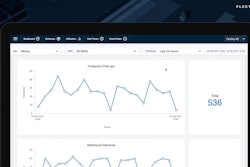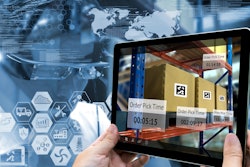
Adaptation and resiliency are critical components of the food and beverage supply chain, and supply chain software solutions are key to the future of any company’s success in 2021.
Total global cold chain tracking and monitoring telematics revenue for fresh and processed food is expected to grow from $62.7 billion in 2020 to $136.4 billion in 2025, according to ABI Research. Hardware consumes the largest portion of revenues, with software growing the fastest at a 14% compound annual growth rate (CAGR) from 2020-2025. This market will continue to grow through a variety of drivers, including regulation, increasing on-demand home delivery, growing complexity of temperature zones and consumer desire for reduced waste, greater convenience and transparency. Enabling technologies include integrated telematics, real-time sensing, transportation management solutions (TMS) and blockchain.
The role, footprint and relationship between brick-and-mortar stores, fulfillment centers and delivery options continue to evolve, with no one solution; yet consumer habits are becoming entrenched.
Data and insights have not been consistently available across organizations, partners and customers, further creating disruption for those who rely on institutional knowledge. Limited person-to-person engagement will also speed up digitization for shipping and warehousing, from delivery confirmations to picking and loading.
The Coronavirus disease (COVID-19) pandemic has accelerated early-stage robotics from fulfillment centers to delivery bots. Governments have granted exemptions for road-based autonomous delivery, and growing numbers of fulfillment centers have needed additional support to address sheer volume, safety spacing and employee shortages.
The pandemic has also laid bare gaps in documentation and tenuous contingency plans from finished goods to raw materials. Collaboration across the value chain is needed, and a siloed group of legacy solutions (home-grown and enterprise) no longer make sense. Cooperation and integration can reduce costs, errors and time.
Examples of this include systems integration across telematics systems, TMS, supply chain management (SCM) systems, warehouse management systems (WMS), enterprise resource planning (ERP) systems, emerging technologies like blockchain and supply chain mapping software that enables the tracing of products to their source materials, thus supporting transparency and resiliency.
Compliance to the FDA’s Food Safety Modernization Act (FSMA) rule on the Sanitary Transportation of Human and Animal Food lends itself to robust temperature control operations. The FDA, CDC and OSHA have also published guidance for COVID-19, including for distribution operations. EU regulation includes regulation-compliant temperature recorders with EN12830 and EN13486 for recorders and monitoring.
Challenges of a technology-driven supply chain
One challenge is the fragmented telematics landscape. Numerous fleets have not yet integrated their cab-installed core telematics units with their cold chain solutions. Fleets have also demonstrated subscription fatigue from multiple software-as-a-service (SaaS) providers, along with their individual dashboards, requiring additional actions from both drivers and operators. Integration through open application programming interface (API) portals and software development kits (SDKs), along with strategic partnerships to create a unified user interface (UI) and user experience (UX) as well as backend systems is needed.
Some cargo and conditions require more frequent updates for any out-of-spec cargo. This can include frozen foods and high-temperature weather. A combination of technologies on the horizon will provide greater speed, bandwidth and new use cases. The Internet of Things (IoT), RFID and 5G will evolve current capabilities into more intelligent, integrated and value-add solutions.
Benefits of emerging technologies
Cloud-native TMS offer faster onboarding and lower cost to implement. These solutions run across the supply chain from dock to dock or dock to door, with a focus on reliable execution, enabled from big data, smart algorithms, machine learning, automation and real-time visibility and decision-making. Adoption is driven from ever-compressing delivery expectations from exponentially growing e-commerce. TMS also supports flexibility to address unplanned changes like surge demand, weather or closures that allow changes in mode, size of shipments and end points. Proven ROI is the main argument for TMS adoption. Other adoption triggers include capacity constraints, which are growing ever tighter (including driver shortages back to 2018 levels) and pushing up costs toward the double-digits. Beyond the fact that consumers and businesses continue to push for more granularity in answering “where’s my stuff?” with a real-time response. Synergistic technologies such as predictive analytics, automation, real-time tracking, machine learning, artificial intelligence (AI) and blockchain will continue to evolve for even greater flexibility, improved customer support and enhanced forecasting capabilities.
Blockchain is completely decentralized, leveraging digital signatures, cryptographic hashing and consensus mechanism methods to enable parties to transact directly in a secure and trusted manner. Transportation, shipping, distribution and storage are key verticals for blockchain, which can provide improved transparency and scalability, reduce risks and promote innovation.
Within SCM, there are key opportunities in logistics, location, tracking and asset and inventory management. The food and beverage sector represents a $587 million revenue by 2025, growing at an estimated 46% CAGR between 2020-2025.
The industry has also seen material growth in cold chain investments.
Risk vs. reward of software solutions
One potential risk factor throughout 2021 and into 2022 is a supply/demand mismatch between cold chain transport needs for vaccines and those needed for food distribution. There is already a growing driver shortage, leading to idled trucks. With an estimated 3.3 billion doses of vaccines expected in 2021, requiring over 857 trucks per month for outbound only, the questions are where, how many and for how long will drivers and cold chain transport be impacted.
In conclusion, adaptation and resiliency are critical components of the food and beverage supply chain. This can be strengthened from solutions offering integrated and end-to-end visibility to optimization of raw materials, SKUs, inventory, routing and asset performance and health. In addition to visibility, greater flexibility is needed through new supply sources and partners such as operations, fulfillment, and transportation. Reliability is the foundation of the supply chain and the result of visibility and flexibility vs. traditional just-in-time and lean strategies. The continuing rise of e-commerce presents major opportunities for firms to adapt the way they source, transport, manage and sell their products. Companies can proactively harness consumer demand, reduce production lead times and delivery cycles, reduce risk, remove friction between stakeholders, mitigate labor and staffing pressures and more.


















